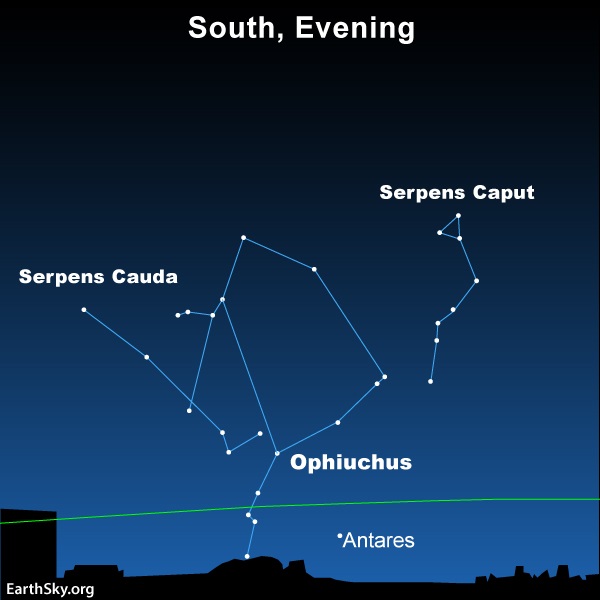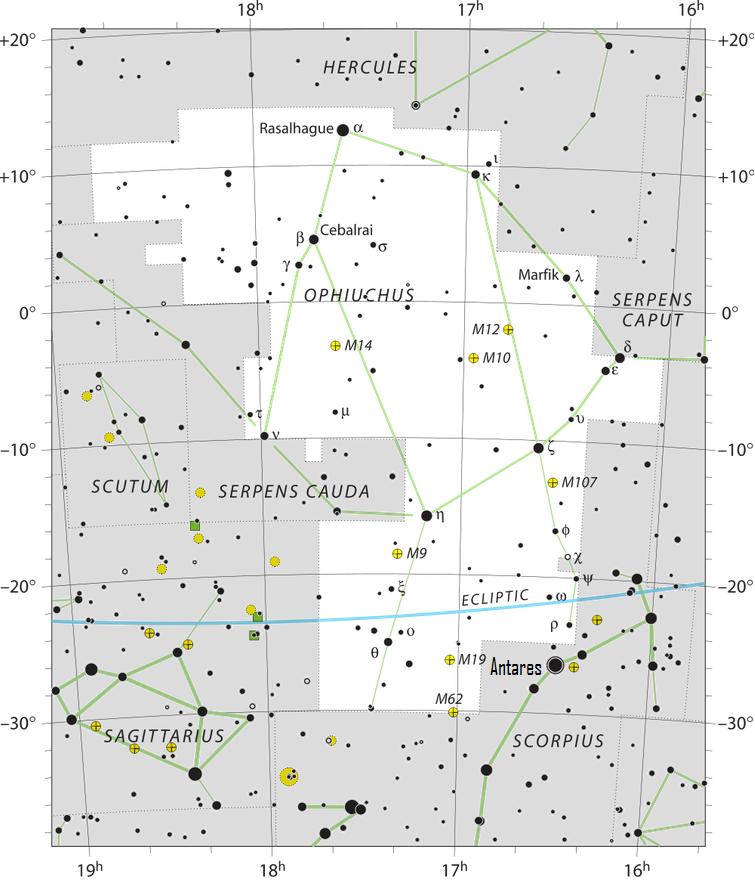
The forgotten constellation
Ophiuchus the Serpent Bearer is sometimes called the 13th or forgotten constellation of the zodiac. That’s because the sun passes in front of Ophiuchus from about November 30 to December 18 each year. And yet no one ever says they’re born when the sun is in Ophiuchus.
Ophiuchus is a constellation – not a sign – of the zodiac.
What are astrological signs? The 12 signs of the tropical zodiac represent equally-sized, 30-degree divisions of the sky. That’s why, for example, the sun resides in front of each zodiacal sign for a precise interval, about a month. Meanwhile, the sun is in front of the constellations for varying amounts of time, for example, in front of the constellation Virgo for about 1 1/2 months and in front of constellation Scorpius for about a week.
What are astronomical constellations? The ancient stargazers picked out patterns among the stars, named them, and associated them with legends and myths. Early in the 20th century, the International Astronomical Union (IAU) agreed on official constellation borders. The constellations vary in size and have many different shapes. The constellations of the zodiac are those in which the sun – and moon and planets – all travel. For as long as anyone can remember, we’ve had 12 constellations of the zodiac. Their names are the same (approximately) as the 12 signs of the zodiac.
If include Ophiuchus – which also holds the sun within its borders for part of every year, too – there are 13 constellations of the zodiac.
Read more: The Constellations by the IAU

Ophiuchus a short hop north of Antares
You can see Ophiuchus the Serpent Bearer on these July nights. Its stars are faint, and you’ll need a dark sky. Look for Ophiuchus in the south at nightfall from the Northern Hemisphere. From the Southern Hemisphere, look more overhead around mid-evening.
The bright red star Antares in the constellation Scorpius the Scorpion can help you find Ophiuchus. Look for Ophiuchus a short hop to the north of Antares.
Ophiuchus’ brightest star – the 2nd-magnitude star called Rasalhague – highlights the head of Ophiuchus. See Rasalhague in the Ophiuchus chart below. Rasalhague is nowhere near as bright as Antares, though.
Help support posts like these at the EarthSky store. Fun astronomy gifts and tools for all ages.

Ophiuchus, snake venom, and access to immortality
On sky maps, Ophiuchus the Serpent Bearer is depicted as holding Serpens the Serpent, which is considered a separate constellation. According to ancient Greek star lore, Ophiuchus is Asclepius, the physician who concocted a healing potion from the Serpent’s venom, mixing it with the Gorgon’s blood and an unknown herb. This potion gave humans access to immortality, until the god of the underworld appealed to Zeus to reconsider the ramifications of the death of death.
Even today, the Staff of Asclepius – the symbol of the World Heath Organization – pays tribute to the constellation Ophiuchus the Serpent Bearer.
Bottom line: Will you see faint Ophiuchus, the overlooked zodiacal constellation, tonight?
Read more: Born between November 29 and December 18? Here’s your constellation
Dates of sun’s entry into each constellation of the zodiac
Enjoying EarthSky so far? Sign up for our free daily newsletter today!











